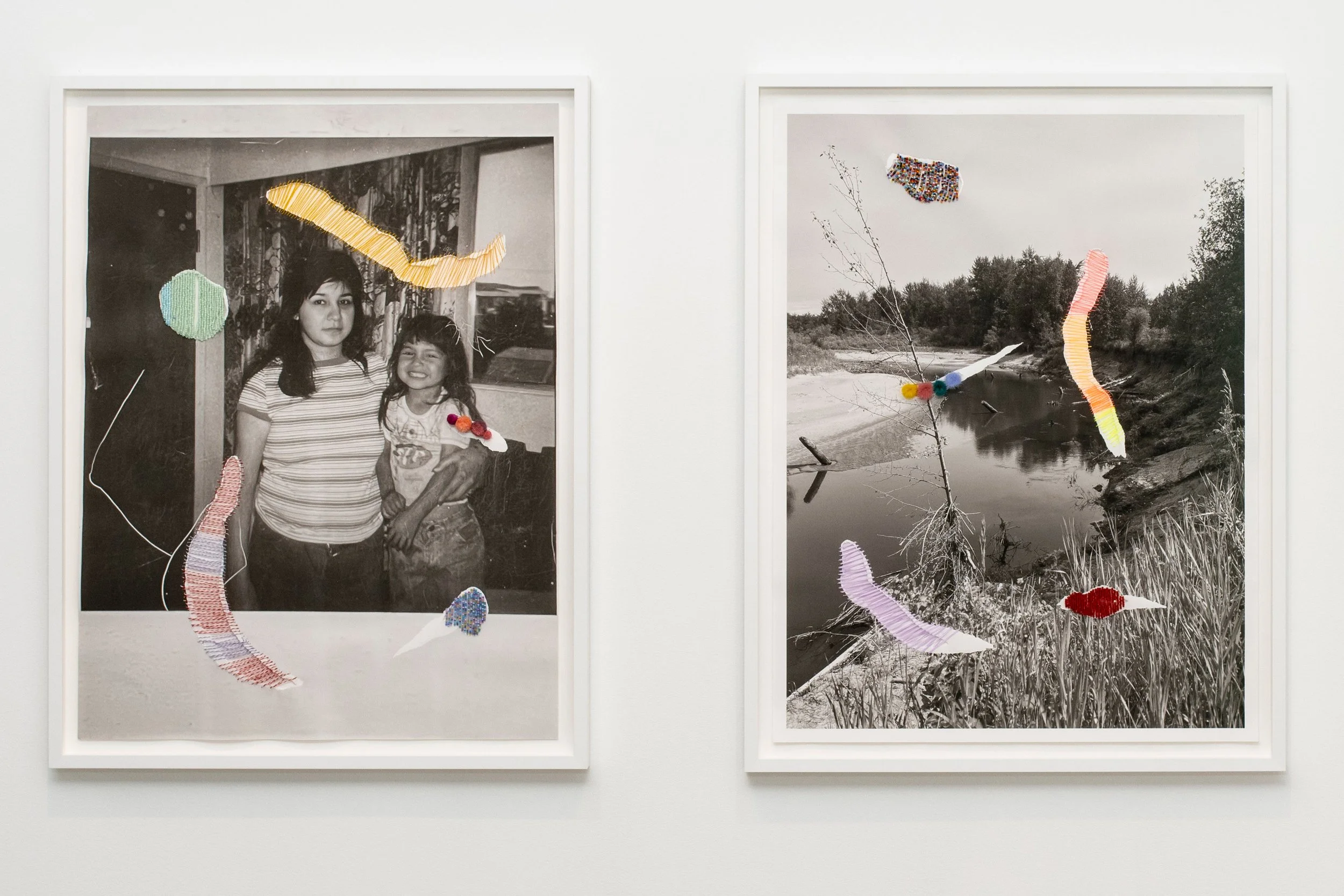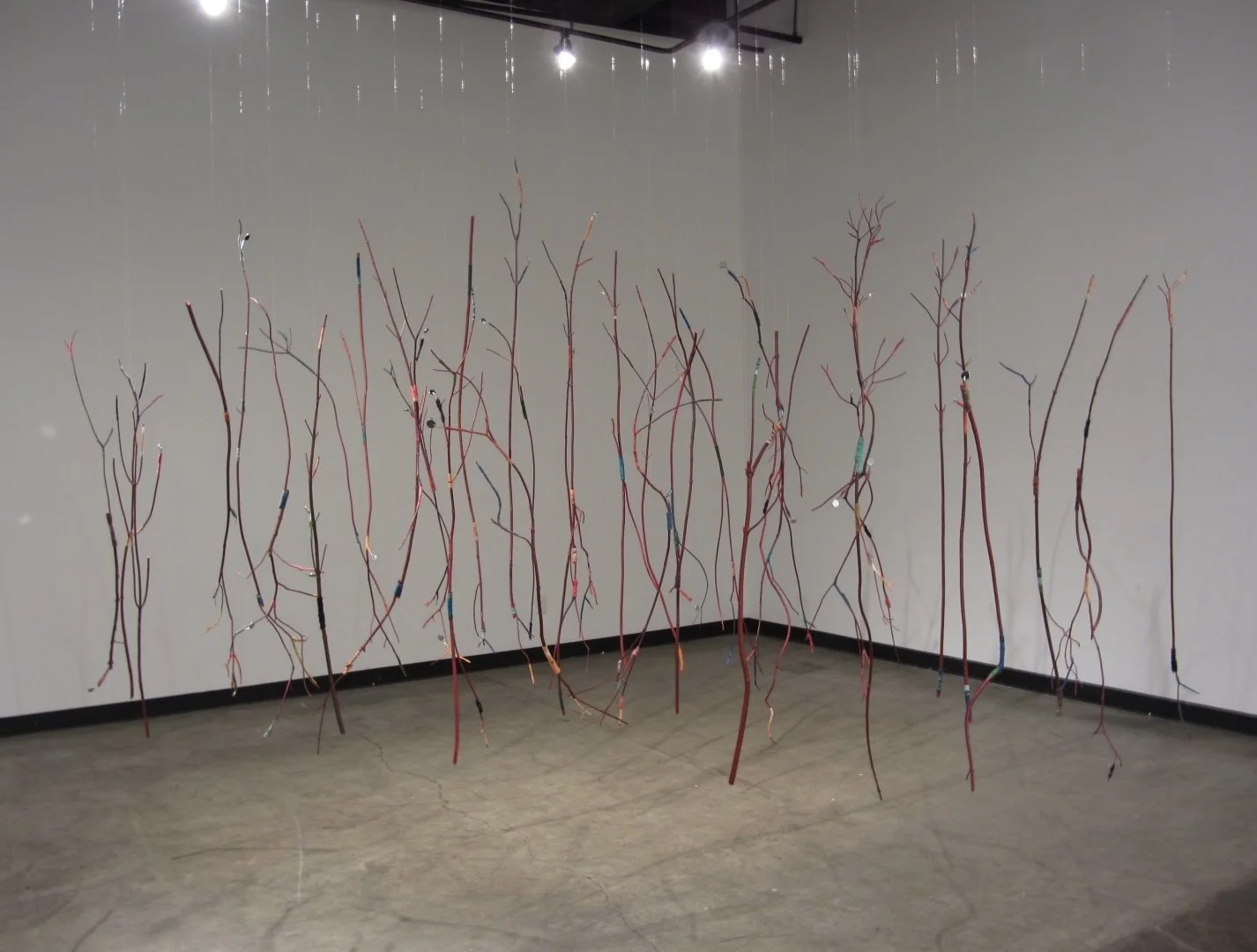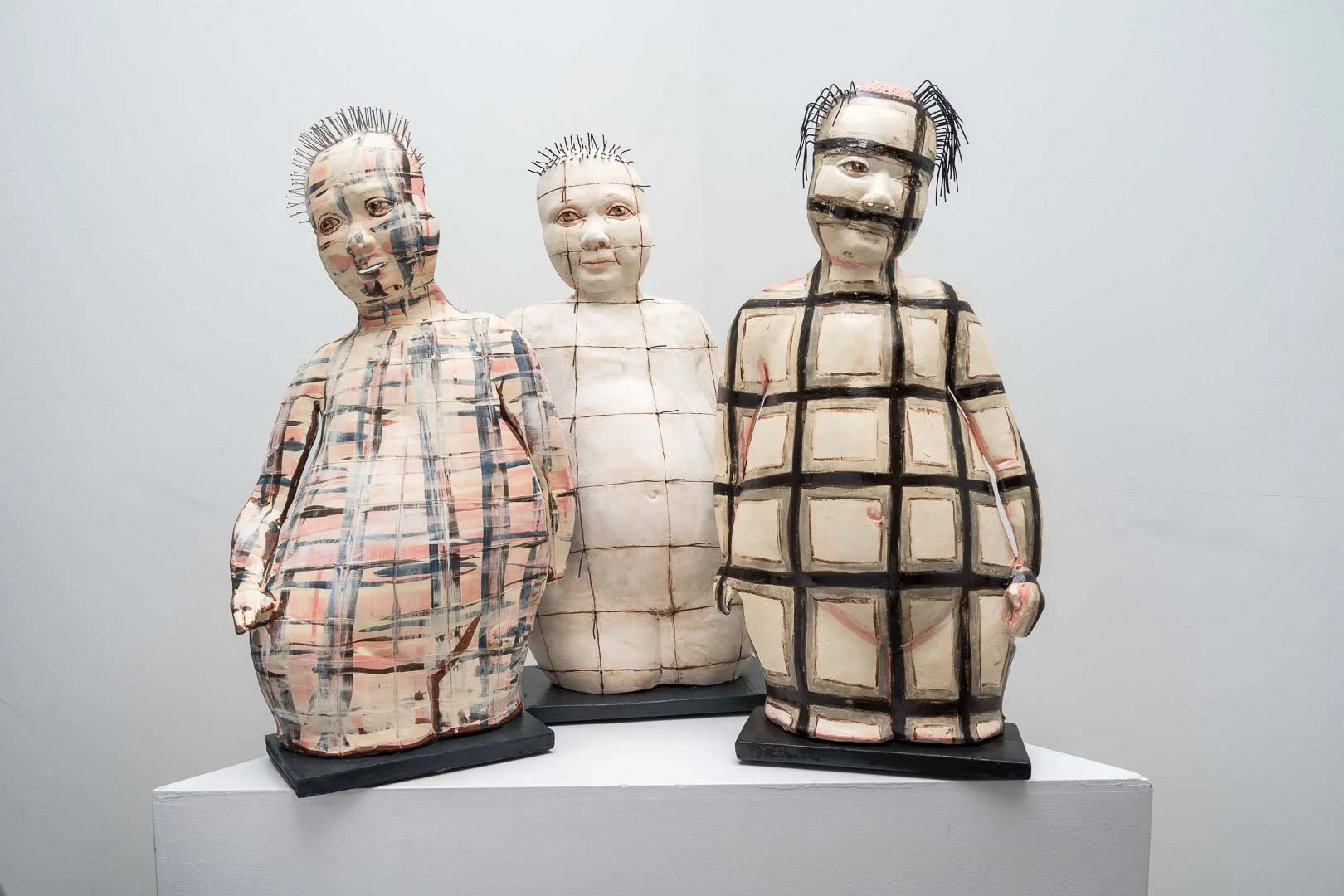Manuel Axel Strain taps childlike wonder and Indigenous knowledge at the Polygon Gallery
Family photos, pictographs, and landscapes interweave in xʷəlməxʷ child

Tracey Strain/Eustache, Eric Strain, Elliy-May Eustache, from the Polygon Gallery’s Manuel Axel Strain: xʷəlməxʷ child.
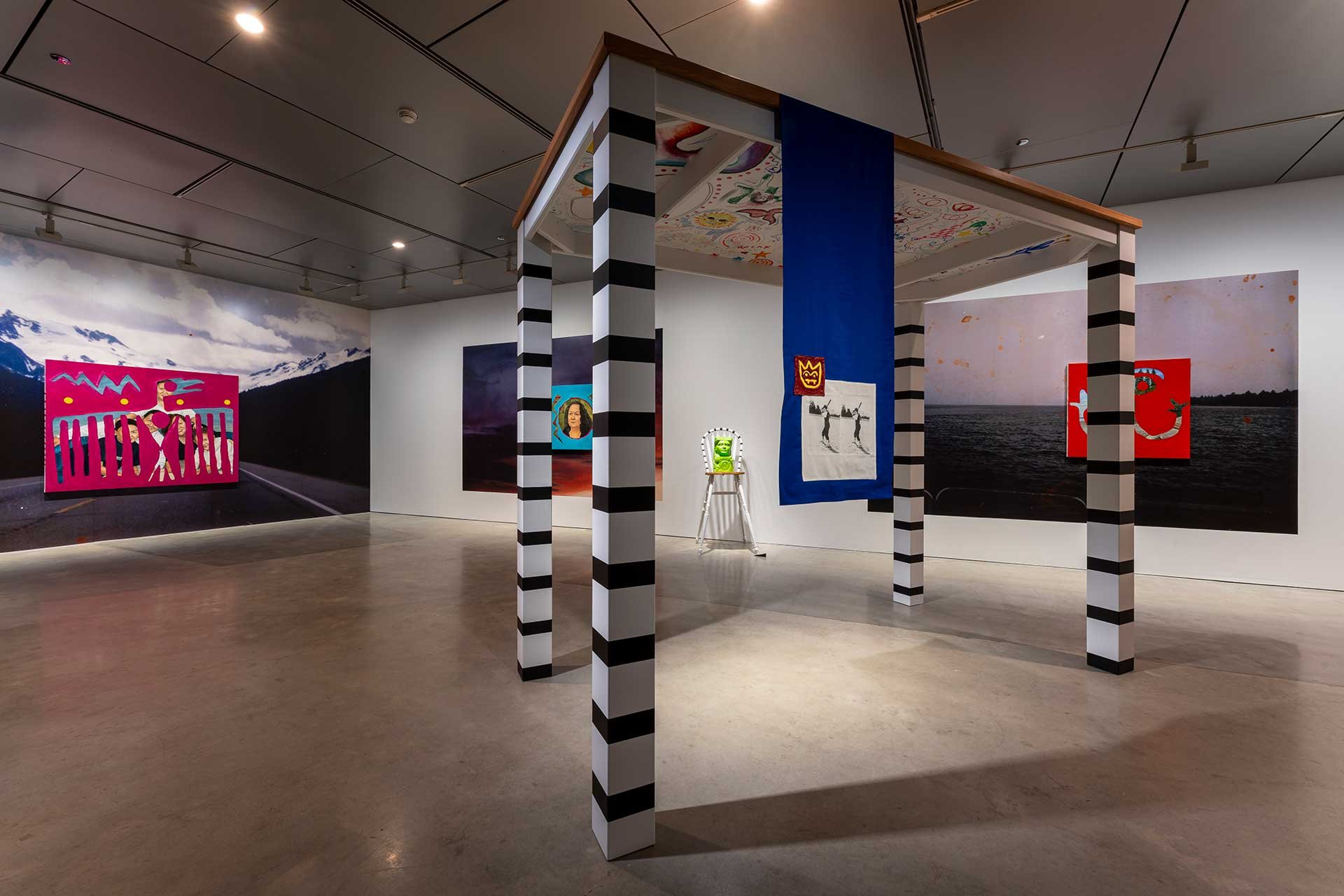
Installation shot of Manuel Axel Strain: xʷəlməxʷ child. Photo by Akeem-Nermo
The Polygon Gallery presents Manuel Axel Strain: xʷəlməxʷ child until May 11
MANUEL AXEL STRAIN explores family bonds and a sense of belonging from the perspective of childhood nostalgia in the new exhibit called xʷəlməxʷ child, at The Polygon Gallery.
Through vivid paintings that morph into pictographs set against photographic backdrops, the 2-Spirit artist of xʷməθkʷəyəm (Musqueam), Simpcw, and Syilx descent offers a vision that suspends ordinary reality. Their work also questions conventional divides, such as linear time and interpersonal relations.
An oversized table dominates the centre of the gallery space, covered with juvenile drawings in crayon and marker, reminiscent of similar drawings on Strain’s childhood bunk bed, which played a pivotal role in shaping their artistic practice. In their speech at the exhibit opening, Strain shared how their parents encouraged their creative freedom in the same way, allowing them to draw on their childhood bed and bedroom walls.
Strain’s familial and interpersonal bonds are at the heart of this show curated by Elliott Ramsey: the walls of the gallery are adorned with painted portraits of Strain’s family and friends alongside xʷməθkʷəyəm landscapes, overlaid with vivid crayon-like imagery inspired by Salish pictographs. Strain also superimposes these pictographic forms, masklike, over the faces of children in family photos, such as Tracey Strain/Eustache, Eric Strain, Elliy-May Eustache, reinvigorating ancient tradition within modern medium and context.

Installation shot of Manuel Axel Strain: xʷəlməxʷ child. Photo by Akeem-Nermo
Each wall of the gallery features a landscape representing the sea, sky, and land—distinct landmarks of the artist’s homelands.
“I view all of our relatives as family,” Strain said at the gallery opening, referring to the importance of representing both human and natural connections within the exhibit. “So when we look at a tree, or all the different plants, or even the water or the air, we see those as family too, and we cherish and value them just as much.”
Through this imagery, Strain blends xʷməθkʷəyəm, Secwépemc, and Syilx knowledge systems with Western psychology to envision a child's perspective on the world, one that exists beyond traditional boundaries. Through their art, they invite viewers to reconsider how we perceive the world and our place within it. ![]()
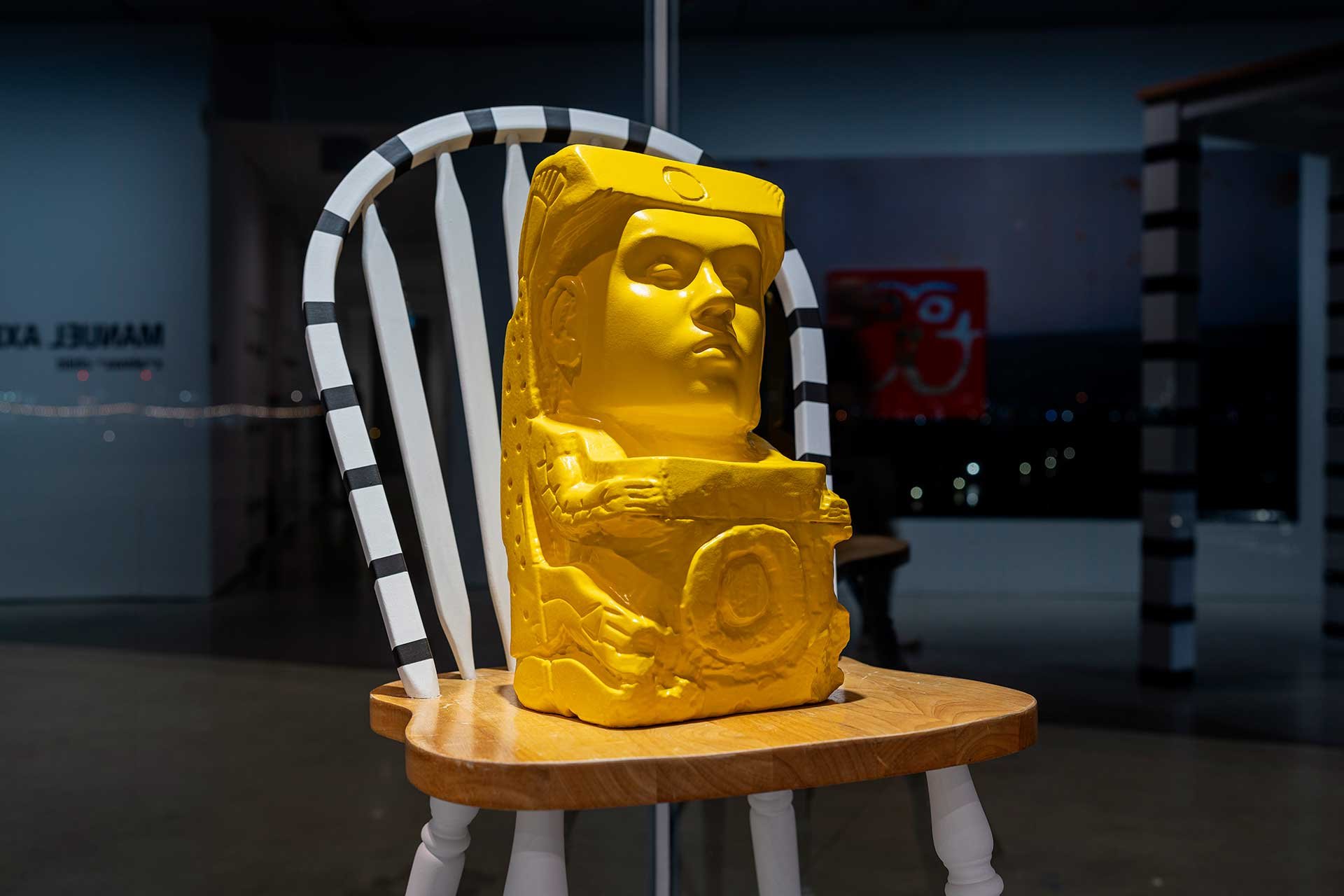
Installation shot of Manuel Axel Strain: xʷəlməxʷ child. Photo by Akeem-Nermo
Emma Jeffrey (she/her) is a Métis and Irish-Canadian writer and editor raised in Vancouver on the unceded territory of the Sḵwx̱wú7mesh, xʷməθkʷəjˀəm, and səlilwətaɬ Nations. She is a member of the Indigenous Brilliance Literary Collective, an Arts and Culture Journalist for Stir Magazine, and former Associate Editor of Digital Projects at The Capilano Review. She holds a diploma in Arts and Entertainment Management at Capilano University.
Related Articles
Working with local doctors and BC Parks Foundation, facility opens Emily Carr: Navigating an Impenetrable Landscape exhibition to those needing to improve their health and well-being
At the Vancouver Art Gallery, Jean Paul Riopelle retrospective covers five decades of his work, from 1942 to 1992
Opening night of the multi-artist exhibition features karaoke, storytelling, and music
New Capture Photography Festival exhibition at the Gordon Smith Gallery of Canadian Art moves the form through beadwork, weaving, handstitching, and more
Paintings and handcrafted installations by four Surrey artists revolve around the intersection of nature and humanity
At the Capture Photography Festival, the filmmaker responds to colonial and industrial pressures with handcrafted practices that call out to her Inuit heritage
Longtime Vancouver arts professional will oversee Eastside Culture Crawl, with Esther Rausenberg moving into new role as artistic director
Board of trustees states that the arts administrator, curator, and writer is leaving “to pursue other professional and personal interests”
Spanning the side of a downtown building as part of this year’s Capture Photography Festival, the installation radiates Indigenous knowledge and Prairie warmth
At VisualSpace Gallery, Gillian Armitage, Esther Rausenberg, and Richard Tetrault reflect on their travels through Japan
Showing at the Polygon Gallery, British photo-artist broke Thatcher-era taboos with luminous photographs that defy easy categorization
Photo-based exhibitions can be found throughout Metro Vancouver and in Whistler this season
Honourees from across the country, including Bruce LaBruce and Kent Monkman, take home $25,000 and a bronze medallion
Sepideh Yadegar’s film tells the story of an Iranian international student photographed at a Women, Life, Freedom protest in Vancouver
Japanese artist’s experimental work features 14 performers, including students from Emily Carr University of Art + Design
Both artists recognized for addressing land, politics, and economies
Surrey Art Gallery is launching its 50th anniversary with the touring exhibition Rajni Perera: Futures
The artist’s work draws equal inspiration from Sinclair Lewis’s 1920s novels and ’90s dystopian sci-fi flicks
Programs include the Community Award, BC Reconciliation Award, Indigenous Business Award, Polygon Award, and Sam Carter Award
Family photos, pictographs, and landscapes interweave in xʷəlməxʷ child
Copresented by PuSh Festival and Vancouver Art Gallery, the genre-bending work merges dance, new media, and video with immersive sound resonators
Solo exhibition centres the artist’s fascination with 20th-century popular culture using found objects and craft techniques
The organization cites financial challenges as the reason it’s ending after nine years
The country’s largest accolade for emerging visual artists comes with a $25,000 cash prize
Craft Council of BC exhibition centres vicarious trauma in response to the iMPACTS research project at McGill University
Works by Frank Stella, Robert Rauschenberg, William Kentridge, Beau Dick, Stan Douglas, and Jeff Wall amid $10-million collection







